Welcome to Climate Drift - the place where we explain climate solutions and how to find your role in the race to net zero.
If you haven’t subscribed, join here:
Hi there! 👋
Skander here.
Today we have Barrett Olafson, a product leader with 15 years of experience, including building and hosting the website for the Emmy’s - and attending them. He is currently a fellow in the first Climate Drift Accelerator cohort, diving into different solution areas with us and transitioning into climate.
You can apply directly to our 2nd cohort here.
He will dive into Enteric Methane, what it is and how large its impact is, and the solutions - from breeding to cow wearables.
Let’s dive in 🌊
Introduction
Livestock production, while essential for global food security, contributes significantly to greenhouse gas emissions, with enteric methane being a particularly potent pollutant. Addressing this challenge requires innovative solutions that not only reduce emissions but also earn the trust of consumers and encourage adoption by producers. This paper explores the impacts of enteric emissions, existing mitigation approaches, and the challenge of encouraging producers to adopt mitigation efforts via multifaceted technology-based engagement methods and implementation strategies.
Methane’s Impact as a Greenhouse Gas
Methane, a potent greenhouse gas, poses a significant threat to the stability of our climate system, with over 80 times the warming potential of carbon dioxide over a 10-year period. Due to its relatively short atmospheric lifespan compared to carbon dioxide, i.e. 10 years versus a hundred years or more, methane's rapid warming effect makes it a critical target for mitigation efforts. This short-term lifespan combined with contributing nearly 25% to current Greenhouse gas warming trends makes methane mitigation an obvious lever to pull in the fight against rising global temperatures.
The lack of comprehensive regulatory frameworks and investment in methane mitigation solutions further complicates efforts to curb methane emissions. Despite recognizing methane's importance as a climate pollutant, less than 2% of current climate finance is allocated to develop methane mitigation solutions. This underinvestment jeopardizes global efforts to reduce emissions and highlights the need for increased focus and resources on methane abatement strategies. Additionally, the recent introduction of legislative initiatives such as the Innovative Feed Enhancement and Economic Development (IFEED) Act of 2023 signals a growing recognition of the importance of addressing methane emissions from livestock production at the policy level. However, bridging the gap between policy intent and effective implementation remains a key challenge in achieving meaningful reductions in methane emissions.
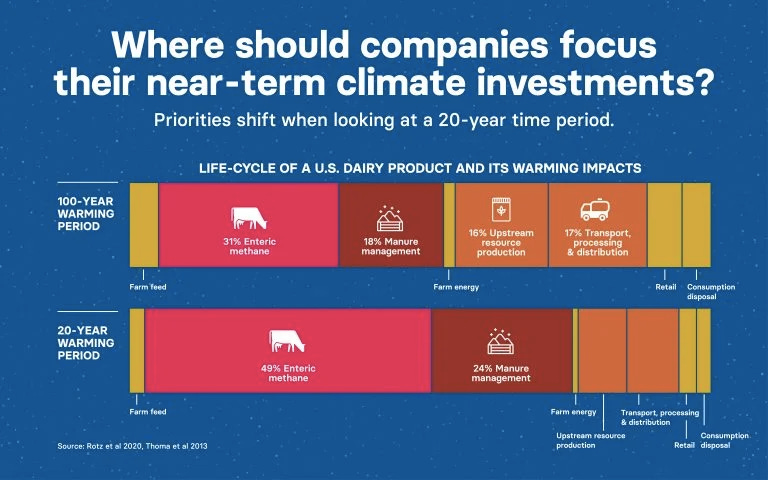
Enteric Emissions & Existing Mitigation Methods
Enteric emissions, stemming predominantly from the digestive processes of ruminant animals like cattle, represent a significant challenge in the quest to reduce greenhouse gas emissions from agriculture. Created by enteric fermentation, which occurs in the digestive systems of ruminant animals such as cattle, enteric emissions are a major source of methane emissions, accounting for 27% of anthropogenic methane in the United States in 2021. Globally, agriculture contributes approximately 40% of total methane emissions, with livestock responsible for about 12% to 17% of total greenhouse gas emissions. Given the substantial contribution of enteric emissions to the climate change equation, it is imperative to explore and implement viable solutions to mitigate their impact as soon as possible.
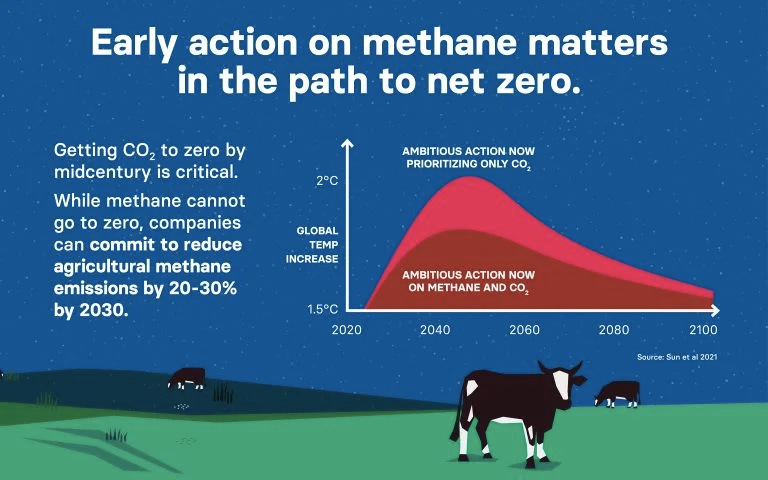
According to the Food and Agriculture Organization (FAO) of the United Nations, the demand for meat and milk is projected to increase up to 70% in 2050 from 2010 levels, bringing with it an expected rise in enteric emissions if not actively mitigated. This trend poses a significant challenge to efforts to limit global warming and mitigate climate change impacts, particularly if efforts to mitigate greenhouse gases remain focused primarily on carbon dioxide. Moreover, methane emissions from livestock contribute not only to climate change but also to air pollution, contributing to the formation of ground-level ozone and particulate pollution, which pose serious health risks, particularly to vulnerable populations such as children.
(Image Source: United Nations’ Food and Agriculture Organization)
While no one mitigation strategy listed below will achieve the complete reduction of enteric methane by itself, it is possible that by combining approaches we’ll be able to achieve near-zero enteric emissions:
Increased Productivity: Optimizing feeding practices can drastically increase livestock productivity while simultaneously reducing methane emissions.
Breeding: Selective breeding for low-methane phenotypes holds the potential to significantly decrease emissions without compromising efficiency, particularly on small-holder farms.
Feed Additives: Innovative feed additives offer the promise of reducing methane emissions in livestock, particularly in slow-release formats.
Vaccines: Vaccine development presents a promising avenue for methane reduction, potentially achieving significant environmental benefits in pasture-based settings.
Wearable Devices: Wearable devices show potential for reducing methane emissions in livestock, though questions remain regarding scalability and animal welfare.
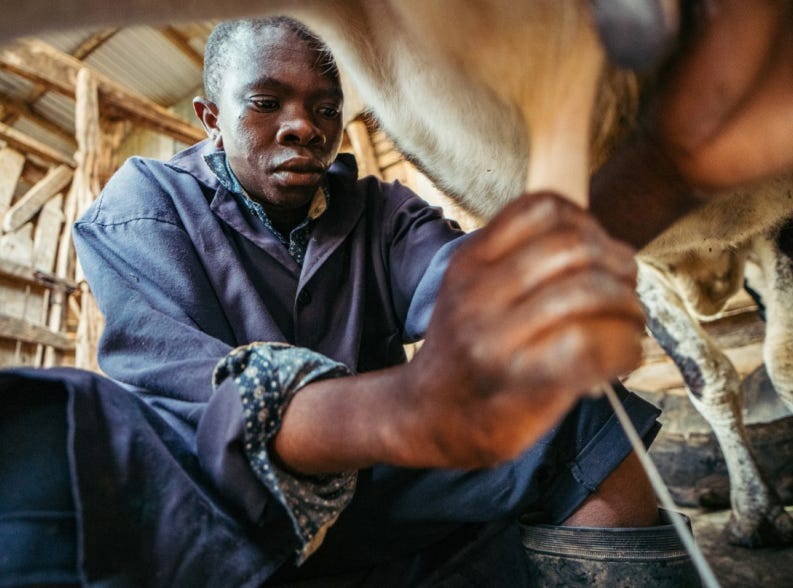
Increased Productivity
Maximizing livestock productivity presents a compelling avenue for mitigating methane emissions in the agricultural sector, particularly due to the force-multiplying consideration that production efficiency is often cited as producers’ highest bottom-line business priority, regardless of their stance on methane emissions. For instance, consider the example taken from the USAID Endline Kenyan Methane Study that a pasture-grazing cow on a small-holder farm produces about 180 liters of milk annually. If we optimize feeding practices and proper diet supplementation, we would less than double the methane emissions from 55 kilos to about 90 kilos per cow per year. However, the corresponding increase in milk production would be remarkable, potentially reaching up to 4,600 liters annually, marking a more than twenty-fold surge over the expected 180 liters in productivity per animal. This would theoretically reduce the number of animals needed by the same factor, thereby drastically reducing the methane released.
This enhancement in livestock productivity holds significant promise for emissions abatement, with projections suggesting a potential reduction of about 20% in the expected emissions increase through 2050. However, the realization of these benefits hinges not only on technological advancements but also on the establishment of effective market systems to adequately make use of the additional milk product. As milk yields in the above example soar, farmers would need assistance in navigating market dynamics to ensure the efficient distribution and sale of their increased output, connecting surplus production with consumers who require it and can afford it. A better-connected and well-supported infrastructure would facilitate the broader adoption of productivity-enhancing practices across the agricultural landscape.
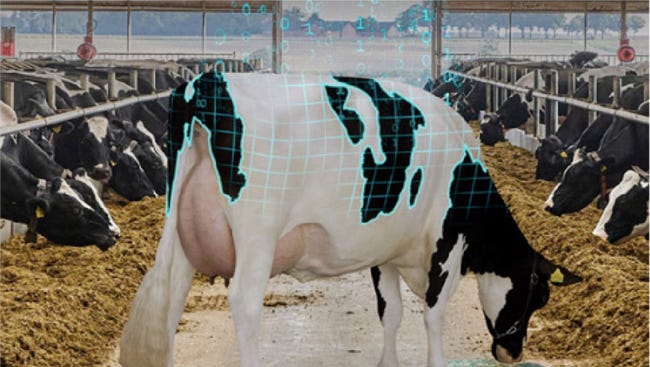
Breeding
Breeding strategies like the use of crossbreeding and reproductive technologies, such as in vitro fertilization and sexed semen, have been identified as effective methods to improve animal genetics and productivity while reducing emissions. Within breeding programs, there exists a distinction between low methane and high methane phenotypes, with their heritability being trackable. By selectively breeding for low-methane phenotypes, significant reductions in methane emissions – potentially ranging from 20 to 30% – can be achieved, all while maintaining high-efficiency genetic lines.
Unfortunately, there’s a market failure currently as the incentives to breed for low methane genetics don’t validate the substantial costs associated with phenotyping (and genotyping) animals, and farmers lack incentives to invest in such genetics packages. Consequently, private genetics companies face a limited business case to allocate capital toward developing low methane genetics, exacerbating the gap between potential solutions and market demand.
Ideally, by identifying and selecting animals with naturally lower methane emissions, breeders could gradually shift the overall methane profile of livestock herds towards more sustainable levels. The heritability of methane-related traits enables the systematic improvement of livestock genetics over successive generations, resulting in lasting reductions in emissions without compromising productivity or efficiency. Challenges would remain in the logistical execution and distribution of large breeding programs, particularly on small-holder farms which are expected to see the most growth through 2050 and are rurally and widely distributed.
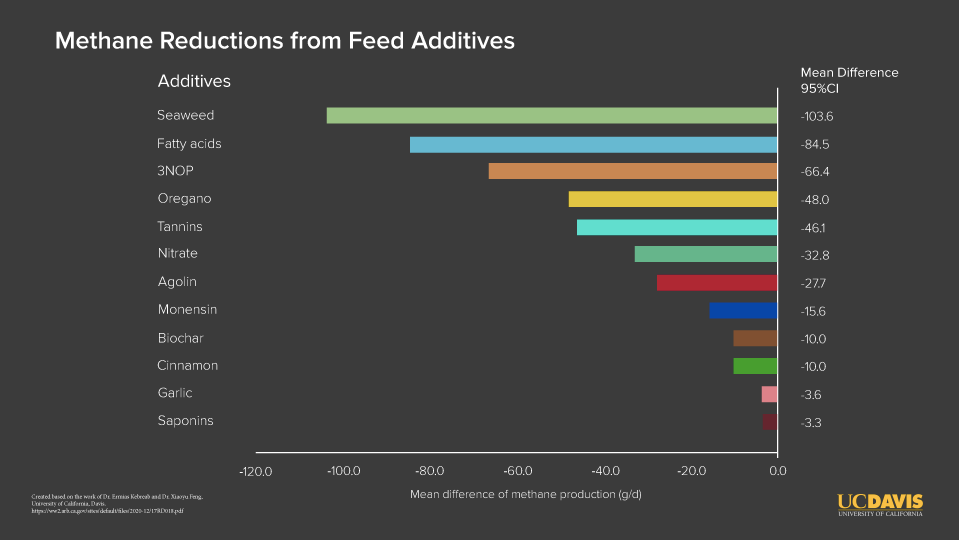
Feed Additives
In the realm of methane mitigation strategies within livestock production, considerable attention and innovation have been directed toward feed additives for years. These additives introduce novel substances into cattle feed or directly into animal rumens that inhibit methane emissions to varying degrees. Broadly categorized, these additives fall into two main classes: alternative hydrogen sinks and methanogenesis inhibitors. Alternative hydrogen sinks, such as nitrate, lactate, and fumarate, act by diverting hydrogen away from methanogens, i.e. anaerobic microorganisms that proliferate by producing methane gas, thereby reducing methane production. On the other hand, methanogenesis inhibitors, like 3-nitrooxypropanol (sold as Bovaer and known colloquially as 3-NOP) and natural compounds found in red seaweed, directly hinder enzymes in the methanogenesis pathway, effectively curtailing methane emissions.
3-NOP, in particular, has demonstrated consistent efficacy in achieving an average reduction of about 30% in methane emissions across various livestock systems. In contrast, the efficacy of bromoform, which can be found in high concentrations in asparagopsis red seaweed, exhibits greater variability, with reductions ranging from 40% to 90% depending on the livestock diet and use, e.g. dairy vs. beef cows, respectively. Prebiotics, including yeast, essential oils, and biochar as additives have also been shown to experimentally reduce enteric emissions. However, challenges persist in understanding the long-term efficacy and adaptation of these additives, necessitating further research to determine their sustained effectiveness over an animal's lifespan.
Moreover, the applicability of feed additives faces practical constraints, particularly in pasture-based livestock systems. The delivery of additives like 3-NOP via boluses—a slow-release format inserted into the rumen—poses logistical challenges due to the size of the 3-NOP molecule and its ability to be rapidly metabolized, requiring frequent administration. Efforts to overcome these limitations through innovative delivery methods, such as slow-release bolus formulations, are underway yet currently still nascent.
The Innovative Feed Enhancement and Economic Development (IFEED) Act is a legislative initiative designed to overhaul the regulatory framework governing animal-feed ingredients, particularly those aimed at enhancing livestock health, reducing enteric methane emissions, and bolstering overall food safety. By amending the Federal Food, Drug, and Cosmetic Act, the IFEED Act proposes to establish a more streamlined pathway for the approval of feed additives and supplements, specifically those targeting methane reduction in livestock. This legislative effort not only aims to expedite the approval process for innovative feed technologies but also seeks to create a distinct regulatory category for substances, i.e. “zootechnical animal food substances”, acting solely within the gastrointestinal tracts of animals. When. the IFEED Act is enacted into law, it’s estimated that the timeline to gain approval on these substances will be reduced by up to 80%, going from 8-10 years to 2-3.
In advance of IFEED’s passage the US Food & Drug Administration (FDA) has invited “firms with these novel products for animals to contact the agency early in the product development process” and is planning on rescinding regulations that require the regulation of certain animal foods with drug claims. In doing so, the IFEED Act not only fosters innovation and sustainability within the agricultural sector but also positions the United States to catch up with other leading countries in this space, like New Zealand, that have made significant strides in advancing methane feed additive-based mitigation technologies.
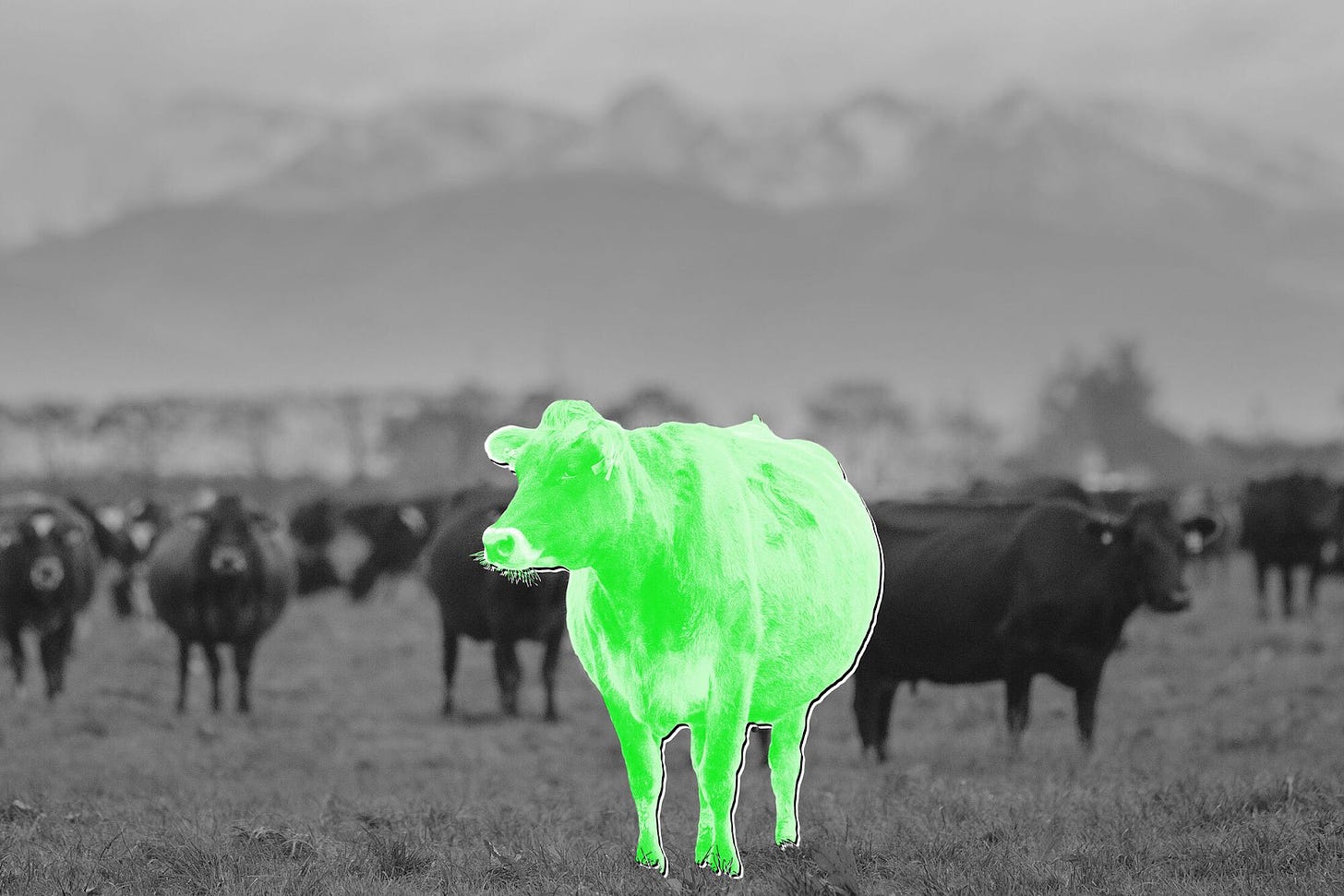
Vaccines
Vaccine development for methane reduction in livestock has shown promise with reason to expect mitigation rates of 30%, although it is still in its early stages. Spearheaded by research institutions in New Zealand and the United States, initial efforts have encountered unique challenges due to the rumen's lack of an immune system and efficient antibody delivery mechanisms. Unlike conventional vaccines for humans, which target specific antigens to elicit an immune response, vaccine delivery in the rumen requires antibodies to bind to their targets within the digestive tract to deactivate methane-producing microorganisms.
To address these challenges, innovative approaches to vaccine formulation and delivery have been necessary. Inducing a mucosal antibody response, with antibodies delivered from saliva into the rumen, presents a fundamental departure from the systemic immune responses targeted by traditional vaccines. Additionally, the rumen's complex microbial ecosystem complicates precision targeting and effectiveness of vaccine-induced antibodies against methane-producing microorganisms. Despite these obstacles, preliminary data suggests that vaccine-mediated methane mitigation could achieve reductions exceeding 20%, offering significant environmental benefits, especially in pasture-based settings where other strategies that require more regular application are less feasible. Vaccines present a near-term scalable solution, leveraging existing vaccination practices in livestock, with an anticipated cost of $2/dose and potentially requiring only two or three doses over the animal's lifetime, thereby ensuring economic viability for widespread adoption.

Wearable Devices
In the realm of methane mitigation for livestock, wearable devices have emerged as one of the more innovative solutions, exemplified by the EU-supported ZELP project. This project has developed a patented wearable device designed for cattle, fitted over the animal’s snout. The device functions by capturing exhaled methane and employing a specialized catalytic converter to transform it into a combination of carbon dioxide and water vapor.
Despite promising results in preliminary tests, where animals wearing the device showcased an average reduction in methane emissions of 26.5% and some achieved a maximum reduction of up to an astounding 32%, challenges to its widespread adoption persist. One significant obstacle lies in ensuring the scalability and affordability of the technology for implementation across diverse livestock operations. Additionally, concerns surrounding the comfort and welfare of the animals wearing these devices need to be addressed through further research and development efforts.
Technology-based Strategies
Addressing enteric emissions faces several challenges, including limited awareness among producers and consumers about the potential and available solutions. Despite the environmental benefits, there is hesitancy among producers to adopt technologies due to historical negative publicity like the pushback on recombinant bovine somatotropin hormone (rbST), which faced resistance despite its efficacy in increasing milk yield and reducing feed requirements. Enhancing productivity, such as through the adoption of rbST on only 11% of U.S. milk cows, would yield significant reductions in methane emissions and free up cropland for other uses. However, due to poor public perception based on inconclusive studies, its implementation has been limited.
Inadequate incentives and insufficient innovation further hinder adoption. Many producers remain unaware of the opportunities and solutions for enteric emissions reduction, with only about 20% considering it important to address now. Additionally, there is a lack of economic incentives to spur adoption, with fewer than 30% of producers willing to bear the costs of enteric solutions, even if reasonably priced. To encourage adoption, financial incentives must be developed alongside innovations that ensure tangible productivity gains, as these are key drivers for producers.
Historically, there has been a lack of trust in methane reduction methods and the entities promoting them, which contributes to producer skepticism. Many producers feel conflicted, as they perceive pressure to reduce methane emissions while already operating on narrow profit margins. Therefore, a more effective approach involves addressing producers' concerns by emphasizing productivity and breeding strategies alongside financial incentives, aligning solutions with their perspectives and economic realities. By prioritizing feasible solutions, the adoption of methane reduction measures becomes more feasible and realistic for producers. This approach meets producers where they are and provides tangible benefits to incentivize action, fostering a more sustainable and collaborative path forward.
In addition to building awareness, fostering innovation and private-public partnerships, three potential technology-based approaches could facilitate the adoption of enteric emissions reduction strategies among livestock producers, particularly if leveraged collaboratively: inset marketplaces, trust-focused enhanced outreach and engagement initiatives, and financial incentives to help offset upfront costs associated with implementing enteric emissions reduction measures.
Inset Marketplaces
Inset markets hold great promise in incentivizing sustainable farming practices and reducing greenhouse gas emissions within livestock supply chains. By allowing farmers to monetize their emission reductions through verifiable carbon and other credits, inset markets provide economic incentives within the livestock value chain for environmentally friendly practices while contributing to the broader goal of enhancing global food system sustainability. Athian, with its groundbreaking livestock carbon insetting marketplace, exemplifies this promise by introducing the first accepted protocol aimed at reducing enteric methane emissions and improving feed utilization. Through Athian's platform dairy and beef farmers have the opportunity to participate in carbon credit programs, certify their emission reductions within the dairy value chain, and contribute to the reduction of their carbon footprint.
This approach holds significant potential for impact, as evidenced by the potential emission reductions if widely adopted. For instance, if the entire U.S. dairy industry were to adopt similar interventions, it could potentially prevent 4.7 million metric tons of carbon emissions annually from enteric, feed, and manure emissions alone. However, despite the promising outlook, inset markets also face notable challenges. These include the need for robust verification mechanisms to ensure the integrity and accuracy of carbon credits, regulatory complexities, market volatility, the varying capabilities and resources of farmers, and competition with established offset marketplaces. Additionally, the success of inset markets relies on the willingness of companies in the supply chain to purchase carbon credits and invest in sustainability initiatives, highlighting the importance of stakeholder collaboration and market demand in driving widespread adoption.
Enhanced Outreach and Engagement
A personalized technology campaign leveraging various media channels such as websites, SMS, and social media could prove instrumental in driving change in enteric emissions by appealing to farmers' bottom line of increased productivity and net value while fostering an optimistic outlook for their farms and families. By harnessing technology, farmers would gain access to tailored information and resources that address their specific needs and challenges, empowering them to make informed decisions to improve their operations. Personalized websites and mobile applications would provide farmers with real-time data on their impact and earned value by integrating enteric emissions-reducing processes, potentially including hyper-specific information on feed additives, breeding programs, and productivity-enhancing measures per animal.
Moreover, technology could facilitate communication and collaboration among farmers, agricultural experts, and researchers, creating networks that enable knowledge sharing and collective problem-solving. Through online forums, webinars, and virtual workshops, stakeholders could exchange ideas, learn from each other's experiences, and access expert advice to optimize their emission reduction strategies. This collaborative approach would foster trust and respect among stakeholders while accelerating the adoption of innovative solutions and best practices.
At a regional level, technology-enabled campaigns could drive localized initiatives tailored to the unique agricultural landscapes and challenges of specific regions. By leveraging geospatial data and analytics, these campaigns identify hotspots of enteric emissions and implement targeted interventions to mitigate emissions effectively. For instance, farmers in regions prone to methane emissions due to specific environmental factors or farming practices might receive personalized recommendations and support to implement sustainable management practices that reduce emissions.
On a national scale, technology-driven campaigns would track and share metrics that demonstrate the collective impact of enteric emissions reduction efforts across the agricultural sector. By aggregating data from participating farms and monitoring key performance indicators, such as methane emissions per unit of milk or meat produced, these campaigns would highlight the tangible benefits of emission reduction measures in terms of environmental stewardship and economic gains. By framing the issue in terms of increased productivity and net value, these campaigns appeal to farmers' interests while fostering a sense of optimism and empowerment, simultaneously encouraging widespread participation and commitment to sustainable practices amongst the stakeholder community and the wider public.
Financial Incentives
Private and public investment will play a crucial role in advancing initiatives aimed at mitigating enteric methane emissions in the agricultural sector. For instance, the USDA's National Institute of Food and Agriculture (NIFA) has allocated $10 million in public funding towards two pioneering projects focused on reducing methane emissions produced by ruminant animals. These transdisciplinary projects signify a significant commitment to scientific research and innovation in addressing the environmental impact of livestock farming. It will be important to continue to build momentum in the public space to unlock further sources of new funding to help drive enteric emissions innovations, particularly from an academic perspective.
In addition to government initiatives, private equity investments present a promising avenue for supporting farmers in implementing enteric methane mitigation strategies. Leveraging the micro-funding model pioneered by platforms like Fundrise and Microventures, individual investors could participate in funding projects that aim to reduce methane emissions on farms. By adopting an individual investor model, private equity investments in enteric methane mitigation strategies offer several advantages for both investors and farmers. For investors, it presents a socially responsible investment opportunity with the potential for long-term financial returns while contributing to the greater social good. Meanwhile, farmers benefit from access to capital without the burden of traditional loans or financing arrangements, gaining access to much-needed capital to offset upfront costs associated with investing in methane mitigation technologies. By pooling resources from individual investors, farmers can implement methane reduction technologies more quickly and effectively, leading to tangible environmental and economic benefits for the agricultural sector holistically. This innovative approach not only diversifies funding sources but also democratizes investment opportunities, allowing individuals to contribute directly to environmental sustainability efforts in agriculture.
Conclusion
In conclusion, the urgent opportunity to address enteric methane emissions from livestock production requires multifaceted and technology-based solutions. As outlined in this paper, enteric emissions represent a significant challenge in mitigating greenhouse gas emissions, with implications for both climate change and public health. It’s quite realistic to envision a combination of these mitigation solutions reducing enteric methane in engaged scenarios by up to 60% by 2030. In larger operations with ample secondary product markets, leading solutions include productivity improvements and breeding, while breeding, vaccinations, and slow-release feed additives show promise in more pasture-based and small-holder settings. However, challenges remain in incentivizing adoption among producers and overcoming logistical hurdles, underscoring the importance of coordinated and earnest outreach campaigns to bridge existing trust gaps.
Technology-driven strategies, including inset marketplaces, enhanced outreach and engagement, and financial incentives, offer pathways to facilitate the widespread adoption of emission reduction measures. Collaboration among stakeholders, including governments, private investors, researchers, and farmers, will be essential to build the trust required to advance these initiatives and drive meaningful progress towards mitigating enteric methane emissions in the agricultural sector. By harnessing the power of collective innovation and collaboration, we can strive towards a more sustainable and resilient livestock production system that reduces its environmental footprint while ensuring food security for future generations.


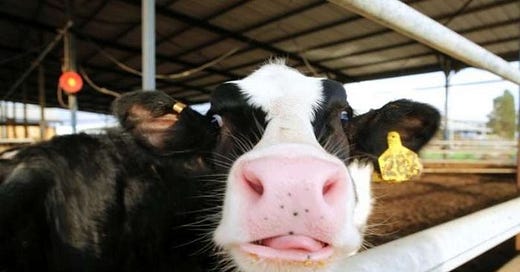



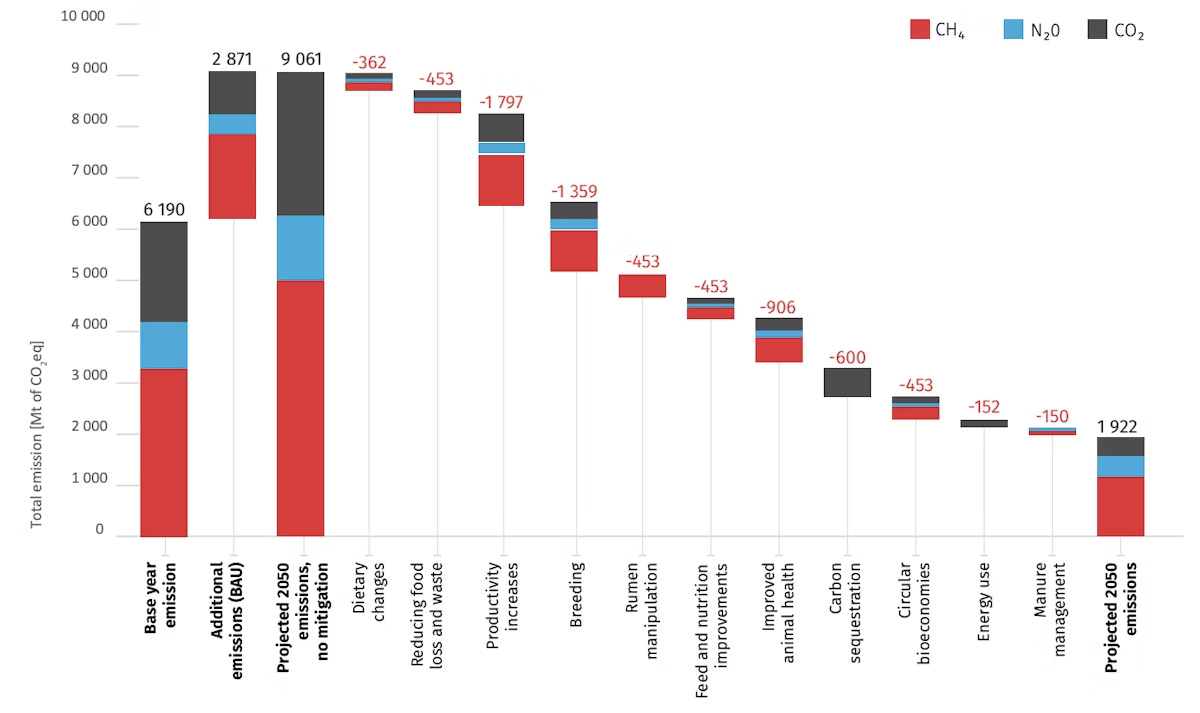
Excellent and thought-provoking article. Two comments
1. On the private-equity side, I sense an opportunity to create a 'basket' of climate-gas reducing technologies. My background is in regenerative ag. A lot of resources are sitting on the sidelines because the more common carbon reduction schemes (see tree planting) have such a long payback in terms of quantifiable carbon reductions. PE is unwilling to provide upfront payments and so many players in the space are struggling to realize enough meaningful revenue to stay afloat before the trees mature. Bundling the long-term carbon reducing power of tree planting with shorter-term methane reducing technologies mentioned here would serve to diversify both risk and payback horizon.
2. I'd love to see the data in the FAO chart broken down by weights depending on whether the reductions are anticipated in Industrialized nations or in the Global South. This information would be meaningful as few developers operate within both spheres.
Great article!
Conceptually, I've heard of the benefits of the enhanced outreach platforms and have always assumed they were targeted at small farmers. From your understanding of livestock operations, do you see these engagement platforms being helpful mostly for small farms, or do you think the 2,500 head operations in Texas and California would use and benefit?
I'm not in the agricultural community and I haven't tracked if there are good examples of these engagement platforms put into practice. I would love to know what lessons have been learned on adoption and utilization in other agricultural and cultural contexts.